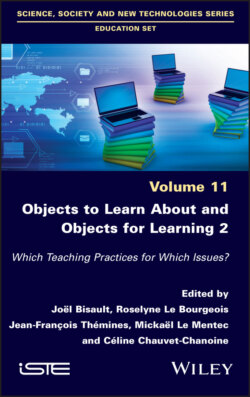Читать книгу Objects to Learn about and Objects for Learning 2 - Группа авторов - Страница 2
Table of Contents
Оглавление1 Cover
2 Title Page
3 Copyright
4 Preface Part 1 of Volume 1 – Objects and Language(s) Part 2 of Volume 1 – Objects and Early Learning Part 1 of Volume 2 – Objects and Representations of Space and Time Part 2 of Volume 2 – Objects and Traces of the Activity Part 3 of Volume 2 – Points of View on Objects and Perspectives
5 Acknowledgements Scientific committee of this publication
6 PART 1 Objects and Representations of Space and Time 1 The Map and the Game: Objects for Learning Geographical Points of Reference in Elementary School 1.1. Introduction 1.2. Points of reference: A special place in geography as it is taught 1.3. Points of reference in upper elementary curricula 1.4. Creating a game about geographical points of reference 1.5. Evaluation periods 1.6. Conclusion 1.7. References 2 The Didactic Use of Physical Objects in the Kindergarten School Calendar Ritual: A Case Study 2.1. Introduction 2.2. Theoretical framework 2.3. The official kindergarten school curricula 2.4. Physical context and the technique of the calendar ritual activity 2.5. Research methodology 2.6. Data analysis and discussion 2.7. Conclusion 2.8. References 3 The Map in the Core School, An Object for Learning 3.1. Introduction 3.2. A reference framework in geographical pedagogy for thinking about maps 3.3. Understanding students’ geographic knowledge through map production 3.4. The map object: Between images of daily practices and formal academic products 3.5. Conclusion: Proposals for revitalizing teaching practices for geography 3.6. References 4 Professional Report: Using a Song as a Mediating Object for Learning Temporal Points of Reference 4.1. Introduction 4.2. Conceptual framework 4.3. Methodology 4.4. Results and discussion 4.5. Conclusion 4.6. Appendix 4.7. References 5 Professional Report: From Tangible Objects to Interactive Maps for Moving Around and Learning an Area – Two Examples with People with Visual Impairments 5.1. Introduction 5.2. Two research examples proposing learning objects for learning about space 5.3. Conclusion 5.4. Acknowledgments 5.5. References
7 PART 2 Objects and Traces of the Activity 6 From the Self-Evaluation Object to the Learning Subject 6.1. Introduction 6.2. Theoretical framework 6.3. First phase: The digital object and its experimental context 6.4. Second phase: The non-digital object and a new experimental context 6.5. Discussion 6.6. Conclusion 6.7. Appendix 6.8. References 7 Creating a Sound Garden: Transforming Recycled Materials into Objects for Learning 7.1. Introduction 7.2. Objects for learning 7.3. Methodology 7.4. Results 7.5. Discussion 7.6. Conclusion 7.7. References 8 The Experimental Protocol Poster in a “Preschool” Class: An Object for Learning or an Object to Learn About? 8.1. Introduction and theoretical framework 8.2. Methodology for data collection and analysis 8.3. Context 8.4. Results 8.5. Discussion 8.6. Conclusion 8.7. References 9 Challenges in First-Years Schools: Early Manifestations of Executive Function 9.1. The first manifestations of executive control at the end of the first year 9.2. The hegemonic status of language in self-regulation and EF 9.3. Self-regulation and EF through action and gestures 9.4. Children’s first challenges in first-years schools 9.5. Discussion 9.6. Conclusion 9.7. References
8 PART 3 Points of View on Objects and Perspectives 10 A Cultural Viewpoint about Objects: Objects that Narrate Cultures and Emotions 10.1. Speaking objects 10.2. Objects and material culture 10.3. Objects: Narrators of histories 10.4. Museums as generators of emotions 10.5. Didactics of objects in a history course 10.6. References 11 Four Researchers’ Points of View 11.1. Overview 11.2. Anne-Laure Le Guern: Material culture and pragmatic preoccupations in training and research 11.3. Mickaël Le Mentec: Socio-educative uses of digital technologies 11.4. Jean-François Thémines: Objects between location and learning 11.5. Abdelkarim Zaid: Objects in the didactics of technology education 11.6. References 12 The Object Stance: Philosophical Perspectives 12.1. Extension and comprehension of the concept of the object 12.2. The dialectics of subject and object 12.3. Pedagogy of the “shock object” and education for contingency 12.4. References
9 List of Authors
10 Index
11 Summary of Volume 1
12 End User License Agreement
